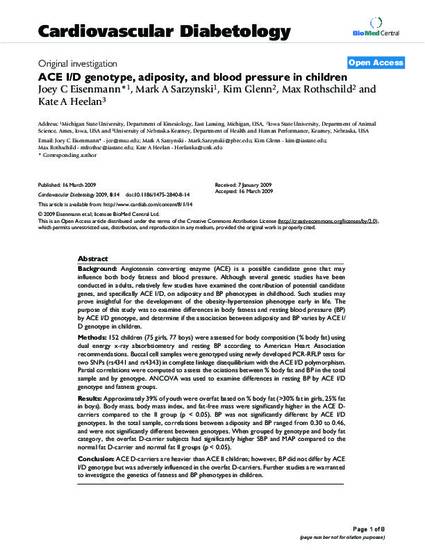
Background: Angiotensin converting enzyme (ACE) is a possible candidate gene that may influence both body fatness and blood pressure. Although several genetic studies have been conducted in adults, relatively few studies have examined the contribution of potential candidate genes, and specifically ACE I/D, on adiposity and BP phenotypes in childhood. Such studies may prove insightful for the development of the obesity-hypertension phenotype early in life. The purpose of this study was to examine differences in body fatness and resting blood pressure (BP) by ACE I/D genotype, and determine if the association between adiposity and BP varies by ACE I/ D genotype in children. Methods: 152 children (75 girls, 77 boys) were assessed for body composition (% body fat) using dual energy x-ray absorbtiometry and resting BP according to American Heart Association recommendations. Buccal cell samples were genotyped using newly developed PCR-RFLP tests for two SNPs (rs4341 and rs4343) in complete linkage disequilibrium with the ACE I/D polymorphism. Partial correlations were computed to assess the ociations between % body fat and BP in the total sample and by genotype. ANCOVA was used to examine differences in resting BP by ACE I/D genotype and fatness groups. Results: Approximately 39% of youth were overfat based on % body fat (>30% fat in girls, 25% fat in boys). Body mass, body mass index, and fat-free mass were significantly higher in the ACE Dcarriers compared to the II group (p < 0.05). BP was not significantly different by ACE I/D genotypes. In the total sample, correlations between adiposity and BP ranged from 0.30 to 0.46, and were not significantly different between genotypes. When grouped by genotype and body fat category, the overfat D-carrier subjects had significantly higher SBP and MAP compared to the normal fat D-carrier and normal fat II groups (p < 0.05). Conclusion: ACE D-carriers are heavier than ACE II children; however, BP did not differ by ACE I/D genotype but was adversely influenced in the overfat D-carriers. Further studies are warranted to investigate the genetics of fatness and BP phenotypes in children.
Available at: http://works.bepress.com/max-rothschild/21/

This is an article from Cardiovascular Diabetology 8 (2009): 1, doi:10.1186/1475-2840-8-14. Posted with permission.